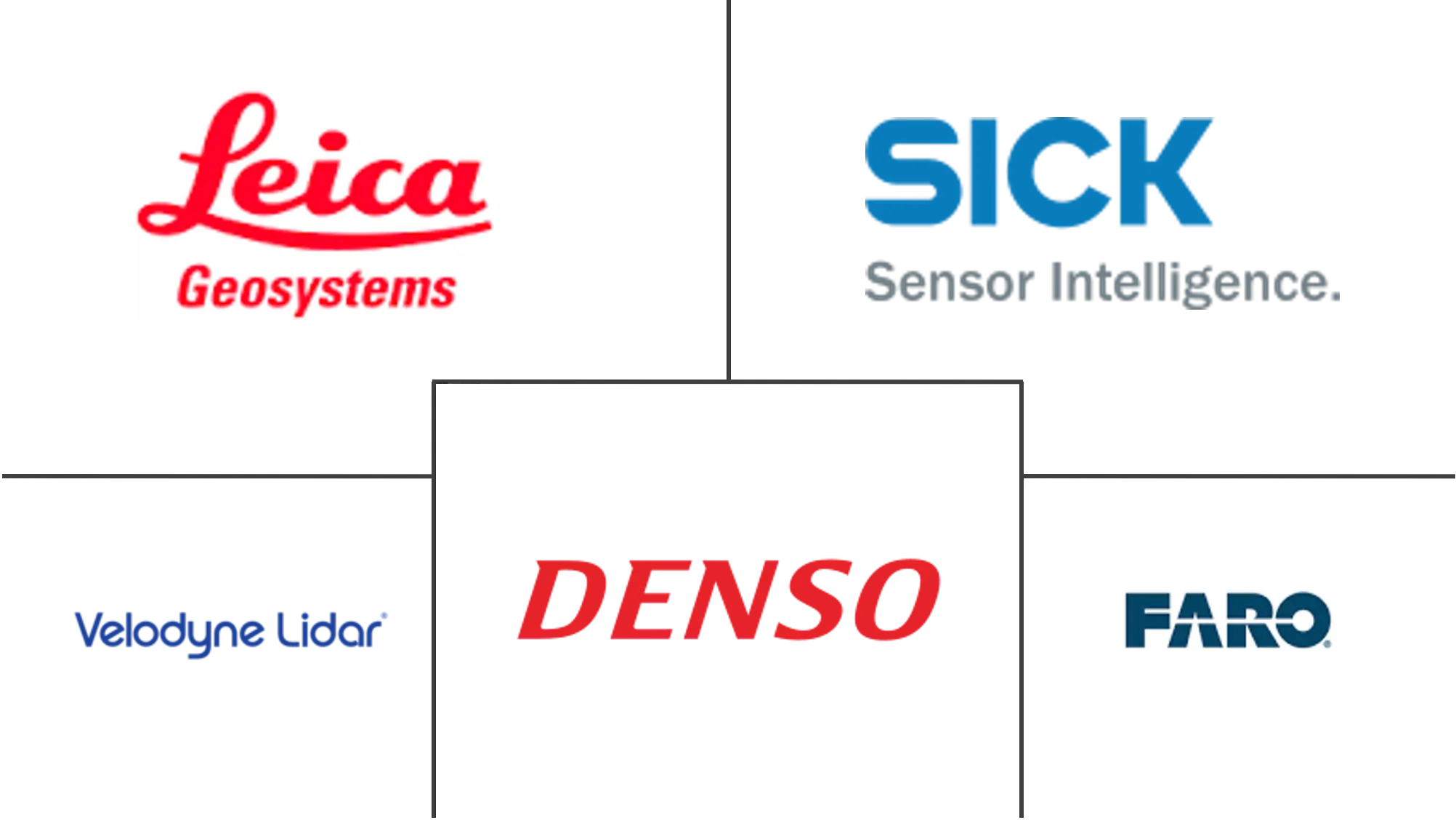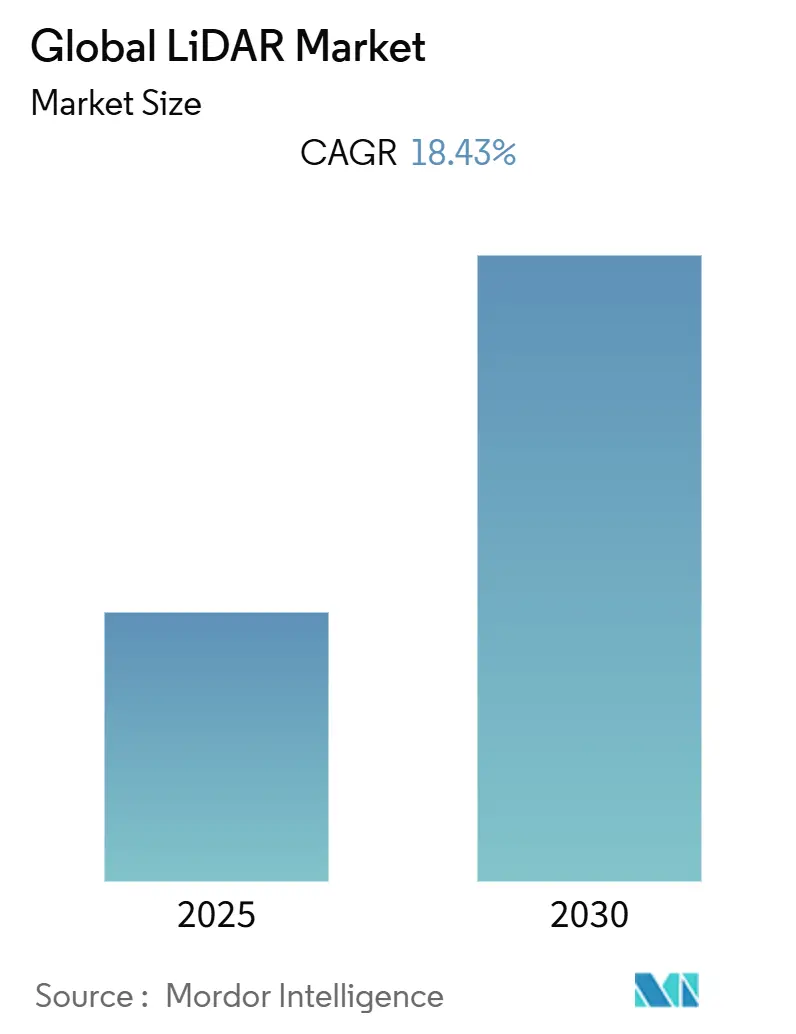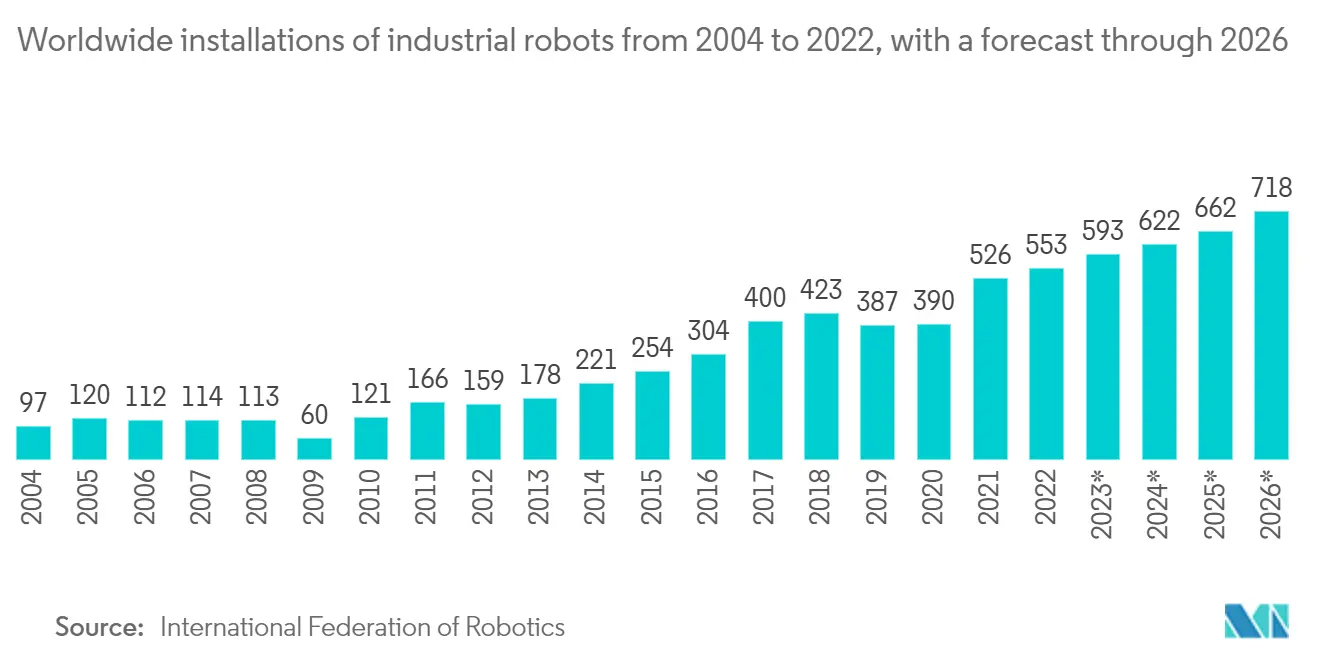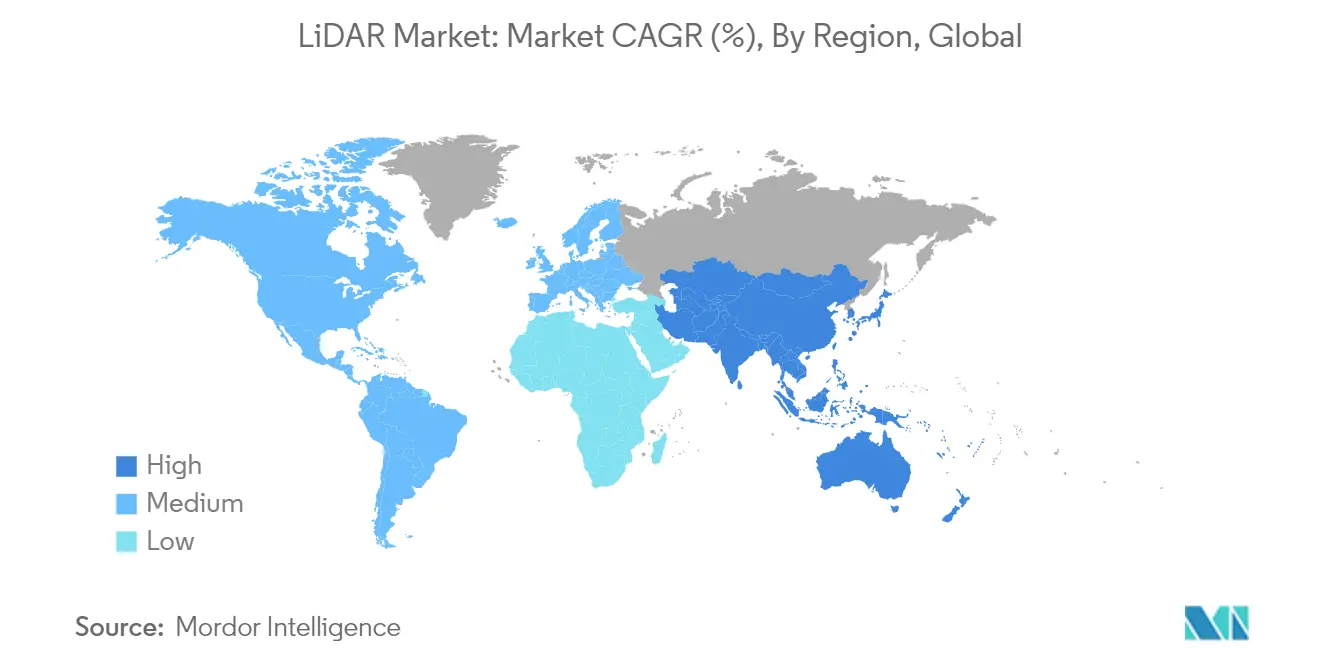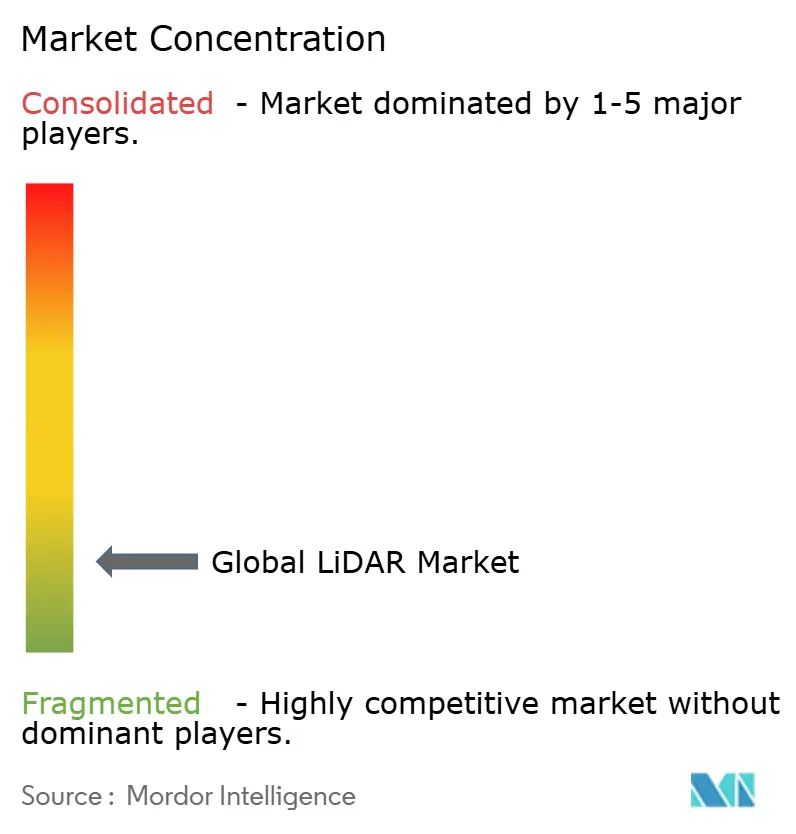LiDAR Market Analysis
The Global LiDAR Market is expected to register a CAGR of 18.43% during the forecast period.
- LiDAR market growth is driven by its rising adoption in UAVs, engineering and construction, and geographical information systems (GIS). The advent of 4D LiDAR and relaxed regulations on commercial drones further fuel this trend. Technological advancements in the automotive realm are propelling the LiDAR market. Companies increasingly integrate diverse technologies, with LiDAR emerging as a pivotal player.
- As the population grows, engineering and civil construction activities are ramping up globally, especially in developing nations. From surveying and mapping to feasibility studies, technology plays an increasingly pivotal role. LiDAR technologies offer precise surveys over vast areas. Moreover, GPS-assisted laser scanners and sensitive cameras empower engineers to build designs that align with project criteria and conduct accurate feasibility assessments. This surge in demand has led to the expansion of many LiDAR service providers.
- In sectors like oil, gas, and mining, LiDAR technology equips scientists and mapping professionals with accuracy and flexibility to scrutinize both built and natural environments. Governmental encouragement for automation and the integration of LiDAR in activities such as flood management further bolster the industry's growth. For instance, the Transport Ministry has mandated LiDAR surveys before new highway constructions in India.
- Unmanned Aerial Vehicles (UAVs) are gaining traction across diverse industries due to their cost-effectiveness and versatility. Initially built for atmospheric studies, cloud observations, and aerosol analysis, LiDAR drones have cemented their role in global climate monitoring.
- Further, the role of LiDAR in automotive sector and traffic management is set to bolster the market growth rate during the forecast period. For instance, in june 2024, Seoul Robotics, an industrial autonomous driving company, successfully deployed its traffic signal system at State Street and 5900 South intersection in Murray, Utah. This system, powered by LiDAR sensor data, is the first of its kind in the U.S., directly controlling traffic signals with LiDAR technology and setting a new standard in traffic management.
- Also, in April 2024, Hesai Technology, a global provider of lidar technologies catering to autonomous mobility, ADAS, and industrial robotics, unveiled its latest offering: the ATX. This ultra-wide field of view (FOV) lidar boasts an extended detection range, enhanced resolution, and a broader FOV, significantly boosting 3D perception for intelligent vehicles. The ATX is built on Hesai's advanced 4th-generation technology platform, featuring notable enhancements in its laser transceiver module and overall size.
- However, factors like high costs, limited scalability, and complex integration challenges are stifling the growth of the LiDAR market. The expensive components and manufacturing processes render LiDAR less accessible, especially for applications sensitive to cost. Moreover, size, weight, and power consumption constraints impede its widespread adoption in compact devices.
LiDAR Market Trends
Robotic Vehicles is Expected to Grow Significantly
- Robotic vehicles are set to dominate the LiDAR market, driven by their rising adoption in sectors like logistics, defense, agriculture, and autonomous transport. LiDAR is pivotal for robotic vehicles, facilitating precise navigation, object detection, and real-time 3D mapping, all vital for autonomous functions.
- Logistics is witnessing a rise in demand for autonomous delivery robots and warehouse automation. Market Players like Amazon, FedEx, and Tesla are embedding LiDAR into their robotic fleets, boosting operational efficiency. With LiDAR building precise environmental models, these robots navigate dynamic settings smoothly, minimizing the need for human oversight.
- LiDAR-equipped unmanned ground vehicles (UGVs) and drones are becoming staples for surveillance, reconnaissance, and battlefield mapping in defense and aerospace. The military's push for real-time situational awareness and pinpoint targeting is accelerating the integration of sophisticated LiDAR sensors in their robotics. With industries leaning more towards automation and autonomous technologies, the demand for LiDAR in robotic vehicles is set to surge, heralding robust market growth in the years ahead.
- Moreover, AI, 5G, and edge computing breakthroughs bolster LiDAR-driven perception systems, amplifying robotic vehicle capabilities. The rise of smart cities and advanced transportation systems is boosting the demand for autonomous shuttles and robotaxis, heavily reliant on LiDAR for operational safety and efficiency. As per the International Federation of Robotics, worldwide shipments of industrial robots are set to surge in the coming years, with projections indicating a reach of approximately 718,000 units by 2026.
North America is Expected to Hold Significant Market Share
- North America is gaining significant benefits from the growing LiDAR market, fuelled by swift strides in autonomous vehicles, smart infrastructure, and industrial automation. Major automotive and tech firms in the region are investing in LiDAR technology, primarily for self-driving cars, bolstering safety and navigation. Furthermore, government-backed initiatives to foster city developments and modernize infrastructure amplify the demand for LiDAR-centric mapping and surveying solutions.
- LiDAR's rising use in defense and aerospace sectors for surveillance, target detection, and terrain mapping propels market growth. Beyond defense, LiDAR's applications are expanding into environmental monitoring, forestry, and disaster management, unveiling new revenue avenues. The region's concentration of LiDAR manufacturers and research entities catalyzes technological breakthroughs, rendering LiDAR solutions more efficient and budget-friendly.
- In North America, the construction and mining sectors harness LiDAR for accurate mapping and automation, leading to heightened operational efficiency. A supportive regulatory landscape and investments in advanced driver-assistance systems (ADAS) bolster the market's growth. The 5G and IoT network rollout further amplifies LiDAR's integration across diverse applications, from robotics to industrial safety.
- In April 2024, at ISC West 2024, Quanergy, a provider of 3D LiDAR technology, unveiled two new sensors: the Q-Track HD and Q-Track Dome. These additions bolster Quanergy's already acclaimed Q-Track LR (Long Range) offering, positioning the company as the provider of high-performance 3D LiDAR solutions. Quanergy's Q-Track boasts detection, classification, and tracking capabilities that outpace legacy technologies, delivering 20 times the accuracy at under half the cost.
- Also, in July 2024, Censys Technologies rolled out the Mapper+ Version C, an advanced UAS LiDAR system from YellowScan. Paired with the Sentaero 5, this upgraded payload boasts features elevating LiDAR functionalities. By integrating BVLOS (Beyond Visual Line of Sight) missions and operations over dynamic subjects, Censys broadens its utility. The system can effortlessly capture colorized point clouds in a single flight. This enhancement streamlines operations across surveying, mapping, utilities, and environmental sciences and cuts down on required flights, payloads, and data processing time.
LiDAR Industry Overview
The LiDAR market sees intense competition, with numerous large and small players vying for dominance. These players, including industry giants like Sick AG, Velodyne LiDAR, Leica Geoystems AG, Faro Technologies Inc., and Denso Corporation, among others, are actively pursuing strategies such as product launches, technological innovations, strategic partnerships, acquisitions, and collaborations to secure a competitive advantage.
LiDAR Market Leaders
-
Sick AG
-
Velodyne LiDAR
-
Leica Geoystems AG
-
Faro Technologies Inc.
-
Denso Corporation
- *Disclaimer: Major Players sorted in no particular order
LiDAR Market News
- November 2024: Peachtree Corners, harnessing the power of real-world connected infrastructure and 5G, has forged a partnership with Opsys, developer of advanced pure solid-state scanning LiDAR sensor. Together, they are set to introduce and implement Opsys' Advanced LiDAR Technology Opsys Sensors (ALTOS) Gen 2 LiDAR at Curiosity Lab. This initiative not only signifies Opsys' inaugural real-world deployment of the ALTOS but also marks the company's debut collaboration with a municipality and its first venture in the United States.
- December 2024: SiLC Technologies has unveiled its inaugural product, a LiDAR laser line scanner tailored for industrial automation, boasting an accuracy of 1mm from distances of up to 10m. The Eyeonic Trace Class 1 Laser Line Scanner harnesses SiLC's proprietary single-chip FMCW LiDAR, transforming it into a comprehensive inspection and measurement device. This tool adeptly monitors objects on conveyor belts, bucket elevators, assembly lines, and even those being assessed by robotic arms.
LiDAR Industry Segmentation
LiDAR, short for Light Detection and Ranging, employs pulsed laser light in its remote sensing technique to gauge distances to the Earth. By integrating these light pulses with additional data captured by airborne systems, LiDAR produces accurate three-dimensional representations of the Earth's contours and surface features.
The LiDAR market is segmented by application (robotic vehicles, ADAS, environment (topography, wind, and agriculture and forestry), and industrial), type (aerial (Topographic and Bathymetric) and terrestrial (Mobile and Static)), and geography (North America, Europe, Asia, Australia and New Zealand, Latin America, and Middle East and Africa). The report offers the market size in value terms in USD for all the abovementioned segments.
| Application | Robotic Vehicles | ||
| ADAS | |||
| Environment | Topography | ||
| Wind | |||
| Agriculture and Forestry | |||
| Industrial | |||
| Type | Aerial (Topographic and Bathymetric) | ||
| Terrestrial (Mobile and Static) | |||
| Geography | North America | ||
| Europe | |||
| Asia | |||
| Australia and New Zealand | |||
| Latin America | |||
| Middle East and Africa | |||
| Robotic Vehicles | |
| ADAS | |
| Environment | Topography |
| Wind | |
| Agriculture and Forestry | |
| Industrial |
| Aerial (Topographic and Bathymetric) |
| Terrestrial (Mobile and Static) |
| North America |
| Europe |
| Asia |
| Australia and New Zealand |
| Latin America |
| Middle East and Africa |
Global LiDAR Market Research Faqs
What is the current Global LiDAR Market size?
The Global LiDAR Market is projected to register a CAGR of 18.43% during the forecast period (2025-2030)
Who are the key players in Global LiDAR Market?
Sick AG, Velodyne LiDAR, Leica Geoystems AG, Faro Technologies Inc. and Denso Corporation are the major companies operating in the Global LiDAR Market.
Which is the fastest growing region in Global LiDAR Market?
Asia Pacific is estimated to grow at the highest CAGR over the forecast period (2025-2030).
Which region has the biggest share in Global LiDAR Market?
In 2025, the North America accounts for the largest market share in Global LiDAR Market.
What years does this Global LiDAR Market cover?
The report covers the Global LiDAR Market historical market size for years: 2019, 2020, 2021, 2022, 2023 and 2024. The report also forecasts the Global LiDAR Market size for years: 2025, 2026, 2027, 2028, 2029 and 2030.
Our Best Selling Reports
Global LiDAR Industry Report
The global LiDAR market is experiencing significant growth, driven by the increasing demand for 3D imagery in smart cities, infrastructure, and environmental monitoring. The precision of LiDAR in 3D data collection is crucial for urban planning and smart grids, which are essential for sustainable development in smart cities. However, the market faces challenges such as high costs associated with testing and calibration. Despite these challenges, opportunities in advanced geospatial solutions and improvements in sensor technology are propelling the market forward.
The LiDAR market size is expanding, particularly in the Asia Pacific region, due to advancements in infrastructure and agriculture. Key segments such as corridor mapping and aerial surveying, along with the rise of autonomous vehicles and UAVs, highlight the importance of LiDAR in automation and digital mapping. For detailed statistics on the LiDAR market share, size, and revenue growth, Mordor Intelligence™ provides comprehensive analysis and forecasts in their Global LiDAR market reports, available for free PDF download.
Industry analysis indicates that the LiDAR market is poised for substantial growth, with industry information pointing to a positive industry outlook. Industry reports and industry research highlight the increasing industry sales and industry size. Market data reveals a promising market forecast, with market growth driven by key market leaders. The market outlook and market overview suggest strong market predictions and a detailed market review. Market segmentation and market value are also covered extensively in the report example and report pdf provided by research companies.
In summary, the LiDAR market is set for robust growth, supported by detailed industry statistics and industry trends. The comprehensive market analysis, market cap, and market research provided in the report ensure a thorough understanding of the market dynamics and future prospects.

